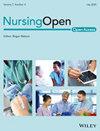中国移民的健康素养和糖尿病信息偏好:澳大利亚横断面研究
IF 2
4区 医学
Q2 NURSING
引用次数: 0
摘要
目的探索澳大利亚华裔移民的健康素养、偏好以及对糖尿病自我管理患者教育翻译材料的参与情况。设计通过医疗服务机构、糖尿病和社区组织对有2型糖尿病风险或患有2型糖尿病的澳大利亚华裔移民进行横断面调查。方法该调查包括三个部分:(1)糖尿病筛查;(2)社会人口信息、临床特征和对翻译材料的偏好;以及(3)功能、沟通和关键健康素养(FCCHL)量表。平均健康素养(FCCHL)总分为 35.3/56(SD = 8.7)。英语水平越高的参与者健康素养越高(p < 0.001)。功能性(p <0.001)、交流性(p = 0.007)和关键性(p = 0.041)健康素养子域也存在这种模式。在澳大利亚居住年限不同,健康素养得分也没有明显差异(均为 p > 0.05)。尽管大多数参与者(75.6%,288 人)愿意接受翻译的糖尿病信息,但只有一小部分人(19.7%,75 人)表示收到过此类材料。本研究强调了护士在将患者教育材料作为护理教育的一部分时,为改善华人移民的糖尿病护理而需要考虑的重要因素。本文章由计算机程序翻译,如有差异,请以英文原文为准。
Health literacy and diabetes information preferences among Chinese immigrants: An Australian cross‐sectional study
AimExplore Australian‐Chinese immigrants' health literacy and preferences and engagement with translated diabetes self‐management patient education materials.DesignThe cross‐sectional survey was conducted with Australian‐Chinese immigrants at risk or with type 2 diabetes recruited via health services, and diabetes and community organisations.MethodsThe survey had three parts: (1) diabetes screening; (2) sociodemographic information, clinical characteristics and preferences for translated materials; and (3) Functional, Communicative and Critical Health Literacy (FCCHL) Scale.ResultsOf 381 participants, 54.3% reported diabetes (n = 207), the remainder pre‐diabetes or at risk (45.7%, n = 174); 34.1% male; mean age 64.1 years. Average total health literacy (FCCHL) scores were 35.3/56 (SD = 8.7). Participants with greater English proficiency reported higher health literacy (p < 0.001). This pattern also existed for functional (p < 0.001), communicative (p = 0.007) and critical (p = 0.041) health literacy subdomains. Health literacy scores did not differ significantly based on years of residence in Australia (all p > 0.05). Although the majority of participants (75.6%, N = 288) were willing to receive translated diabetes information, only a small proportion (19.7%, N = 75) reporting receiving such materials.ConclusionThere is a clear need for co‐designed diabetes patient education materials that meet the needs and adequately reach Australian‐Chinese immigrants. In particular, these materials must support people with limited English‐language proficiency.Implications for Nursing PracticeThis study highlights important considerations for nurses seeking to improve diabetes care for Chinese immigrants when incorporating patient education materials as part of their nursing education.
求助全文
通过发布文献求助,成功后即可免费获取论文全文。
去求助
来源期刊

Nursing Open
Nursing-General Nursing
CiteScore
3.60
自引率
4.30%
发文量
298
审稿时长
17 weeks
期刊介绍:
Nursing Open is a peer reviewed open access journal that welcomes articles on all aspects of nursing and midwifery practice, research, education and policy. We aim to publish articles that contribute to the art and science of nursing and which have a positive impact on health either locally, nationally, regionally or globally
 求助内容:
求助内容: 应助结果提醒方式:
应助结果提醒方式:


